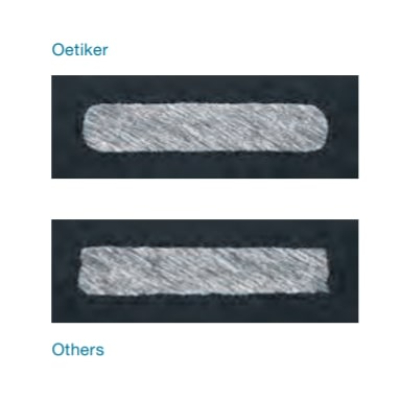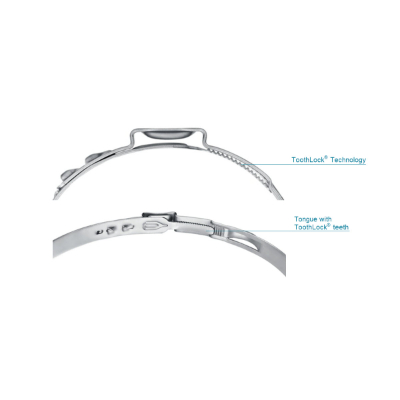Burr free strip edges:
In order to shield clamped parts from scarring and prevent injuries during assembly, Oetiker offers burr free strip edges. Burr-free strip edges prevent the chances of component damage both during & after assembly.

Crimp clamps designed for connecting hoses to fittings & pipes in oil, gas, fluid and coolant lines. Selected Oetiker ear clamps feature a spring-based self-tensioning mechanism for slippage free operation. Available in steel and stainless steel variants.

Oetiker 178 Series StepLess screw clamps having burr-free strip edges to provide complete protection of clamped parts from scarring or mechanical damages. Oetiker 174 Series clamps feature small perforations to help engage and keep the clamp locking mechanism in position once tightened.

Worm drive Oetiker clamps designed for securing pneumatic / exhaust hoses to barbs and fittings in maintenance & repair operations. Screw type fastening mechanism for slippage free installation and steel construction for resistance against hydraulic fluids and industrial chemicals.

Oetiker clamping tools such as straight jaw and ratchet pincers best suited for clamp installations in fuel & cooler lines and air pressure systems. Forged steel construction for ensuring resistance against harsh industrial abuse and insulated handles for hazard proof operation.

Steel hose Oetiker clamp assortments suitable for securing pipes & hoses in hydraulic & cooling line, oil & gas, plumbing and maintenance operations. Jaw pincer with insulated handles for user safety & comfort. Available in zinc plated and plain finish options.
The Oetiker extensive catalogue comprises straps, connectors, clamps & rings and assembly & disassembly tools. Oetiker worm drive clamps are designed for securing pneumatic & exhaust hoses to barbs & fittings in oil & gas operations. These Oetiker clamps feature curled strips with burr-free edges for enhancing surface pressure & ensuring optimum sealing and a simple screw fastening mechanism for easy maintenance & installation. Oetiker clamp pliers are ideal for handling and installation of ear clamps in fuel & cooler lines and air pressure systems. These pincers feature forged steel construction for withstanding repeated use & industrial abuse and insulated handles for user comfort & protection against electrical hazards.

In order to shield clamped parts from scarring and prevent injuries during assembly, Oetiker offers burr free strip edges. Burr-free strip edges prevent the chances of component damage both during & after assembly.
Oetiker's ToothLock technology offers permanent and extremely high compression rates, as well as high expansion resistance for ensuring that the connections stay put. This technology also features a self-locking mechanism for preventing the clamp from loosening and a low spring back rate to enhance the performance over extended periods. Additionally, it makes the Oetiker clamps shock- and vibration-resistant to withstand thermal stress, once installed. The ToothLock technology also integrates multiple tooth locking positions for compensating component tolerances.

Ear hose clamps comprise a band with one or more integrated "ears." These ears are closed using a pincer tool to create a tight, permanent, leak-proof connection at the hose fitting. Ear hose clamps are often used in demanding applications where thin walled hoses, plastics, and soft and hard rubbers are present. Other common variations of Oetiker 2 ear clamps include interlock, adjustable, and Stepless tongue-in-groove clamps to accommodate a variety of application requirements.
Choose single ear clamps (153 Series & 154 Series), if your requirement is to achieve uniform compression around the hose / tube. But, it's recommended to go ahead with a double-ear variant (101 Series & 151 Series ear clamps) if you are dealing with materials prone to thermal expansion / contraction (for an extended clamping range).
A word of caution: Note that Oetiker ear clamps should be crimped in just a single tool stroke. Applying additional force after the first try can damage the clamp.
Plastic hose clamps are a one-piece nylon clamp featuring a toothed, ratcheting mechanism that locks the clamp in place. The ends of these Oetiker clamps feature engineered openings with interlocking teeth. As the openings are pressed together, the teeth interlock, preventing the loosening of the clamp. To release the clamp, grasp one side of the interlocking assembly with a pair of pliers and push sideways. The teeth will slide apart and the clamp will release.
Quick release hose clamps are similar to the common worm drive hose clamps, however, the worm screw is designed to pivot away from the clamp band to fully disengage from the perforations. During installation, the worm screw is disengaged to allow the band to be cinched down by hand. Once the desired amount of slack has been removed, the screw snaps down allowing the worm gear to mesh with the perforations in the band. The band can then be tightened using common hand tools.
Spring clamps, sometimes referred to as constant tension clamps, are a wide band spring steel hose clamp that provides constant pressure on fittings. The spring qualities of the clamp allow it to maintain tension as joints expand and contract with temperature fluctuations.
T-Bolt hose clamps, or racing clamps, are considered a quick release clamp designed with a steel band and a captive bolt T-bolt that is tightened by a hex nut. The "T" end of the bolt is secured in a loop at one end of the clamp band with the opposing end of the bolt fitted through a pivoting housing with its threads protruding out the opposite end.
The threaded end of the bolt acts as a lever, and when pivoted away from the metal band, loosens the clamp. To tighten the clamp, simply pivot the bolt down onto the clamp and secure its place by tightening the hex nut against the bolt housing.
Screw-style Oetiker hose clamps feature a long stainless steel band that wraps around itself as well as a screw that the installer can use to tighten the band. As the installer tightens the screw, it pulls the two ends of the band in separate directions, applying a lot of pressure. Also, their design allows screw-type hose clamps to adjust for several sizes of hose.
Selection of the right Oetiker clamp depends on the nature of applications and several other factors as shown below in the chart:
Always go for high-grade stainless steel Oetiker clamps for applications that involve dealing with highly abrasive environments.
Just measure the outside diameter of the hose. Then, make sure that the measured diameter is in the middle of the clamping range of the clamp.
Certainly, selected Oetiker models like low profile, screw & profile & universal clamps are reusable.
Oetiker clamp tools like a side cutter, rotating or bowl nose cutter can be used for removing the clamp. However, rotating cutters is not recommended as they can damage the hose while cutting the clamp.
Every 3 to 5 years, radiator hose clamps and radiator hoses should be replaced so that the engine is in proper working order. With age and use they can become brittle, swollen, or corroded. The radiator can only cool the car if the internal pressure stays high.
Yes, Selected Oetiker clamps can be used in high-temperature applications. Users should choose a clamp with a temperature rating suitable for the specific application while following the brand's guidelines.
Yes, Oetiker clamps are easy to install. Some clamps have a ratchet mechanism for easy tightening, while others can be tightened using pliers or a screwdriver.